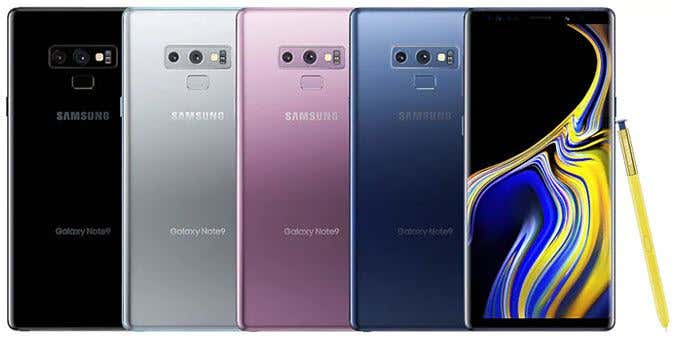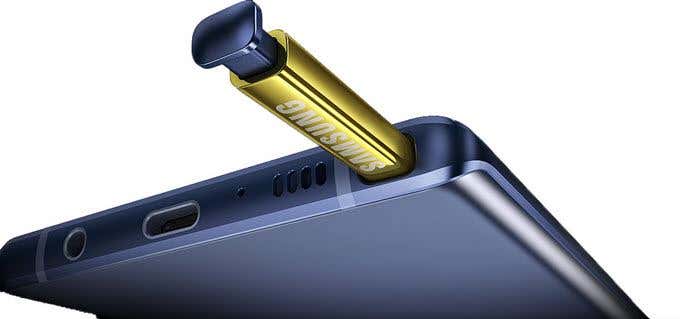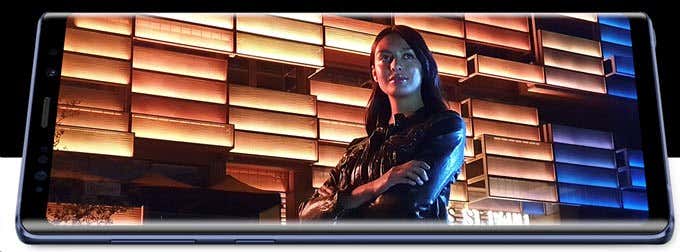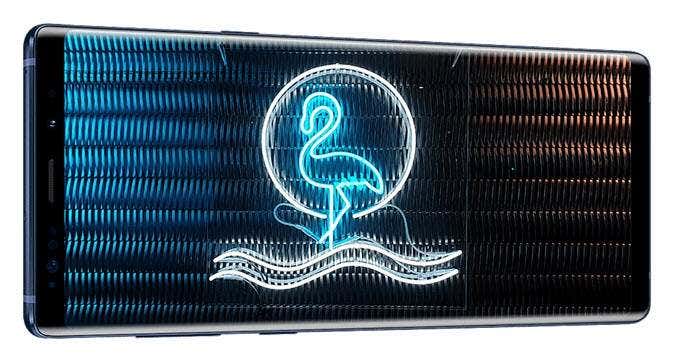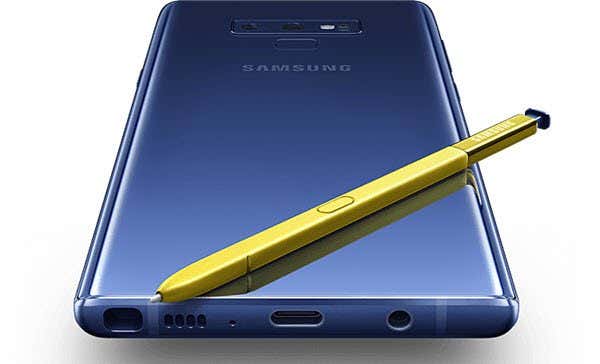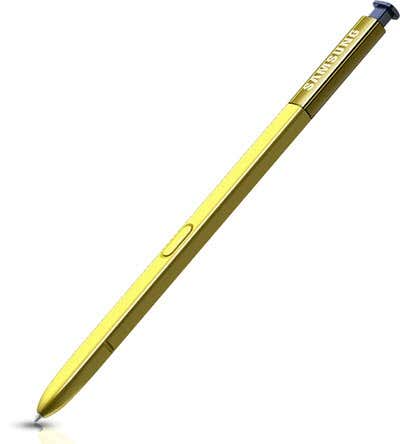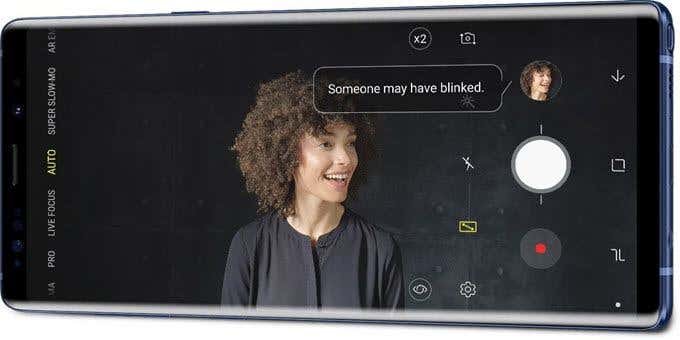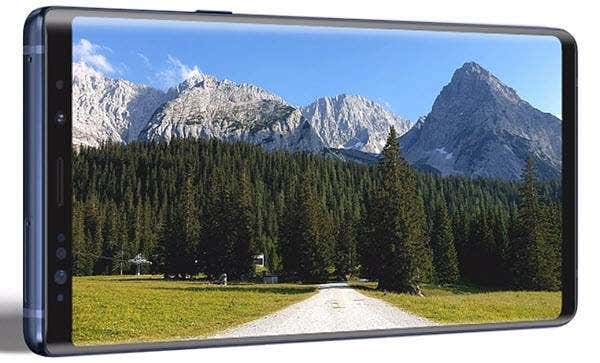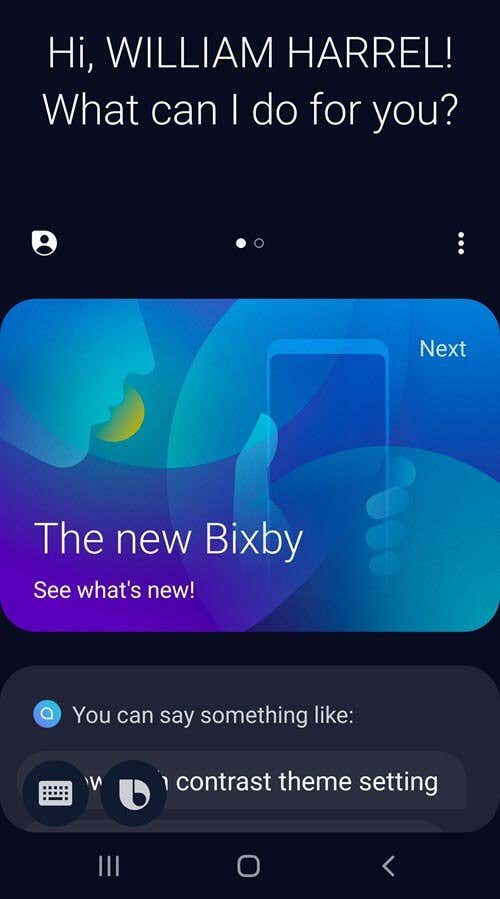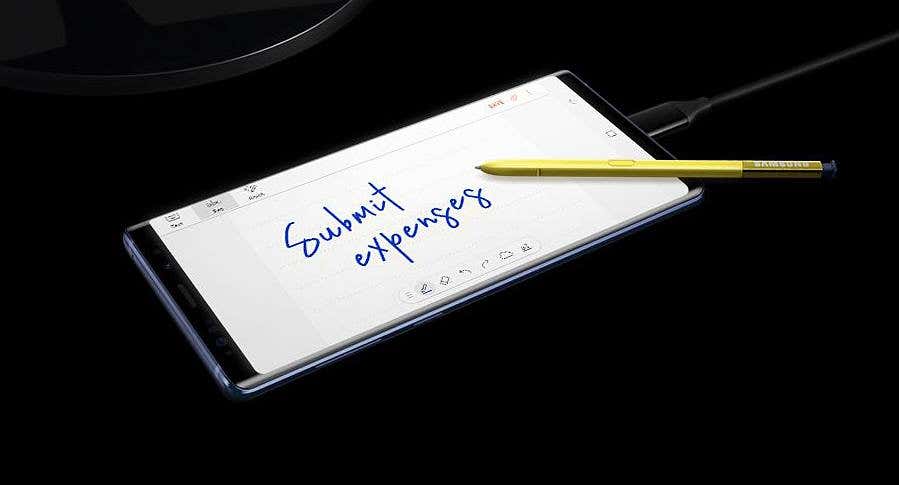It’s called the “Note,” of course, because of its built-in and well-implemented S Pen stylus, which just keeps getting better with each new iteration of the Note smartphone, or phablet. Among other things, the latest S Pen is indeed impressive, as is the Note 9 itself.
Pros:
Beautiful high-res Super AMOLED 6.4-inch displayS Pen matures to include Bluetooth remote controlExcellent cameras with built-in AIHuge storage allotmentDeX mode without the optional dock (all you need is an HDMI cable and adaptor)Big battery, long lifeFastImpressive build qualityTerrific stereo sound
Cons:
CostlyBixby still sucksFingerprint reader too close to the camera
Verdict:
Samsung’s flagship Galaxy Note 9 may cost as much as the iPhone X, but it’s worth it in many ways, including a gorgeous display, long battery life, Note’s famous S Pen, dual-aperture smart camera on the back, and much more.
Galaxy Note 9
Specifications
Design
The Note 9’s physical build and appearance aren’t really new. At 6.3 by 3.0 by 0.34 inches (HWD) and weighing 7.1 ounces, aside from being ever so slightly larger and heavier than the Note 8, the latest note looks very much like its predecessor. It also bares a strong resemblance to the Galaxy S9 and Galaxy S9+. In fact, if you don’t need or want the stylus, the Galaxy S9 or S9+ are both attractive, less-expensive alternatives. In any case, let’s take a look around the Galaxy Note 9, starting with its highly attractive, very well-built aluminum chassis. This is one slick-looking and -feeling phone, with smooth, tight, slightly rounded edges and corners with nearly imperceptible seams. Depending on where you buy it, you also get your choice of vibrant colors, including Lavender Purple and Ocean Blue. The Ocean Blue comes with a yellow S Pen, which writes in yellow on the display in Screen-Off memo mode, and the lavender model comes with a purple pen that uses purple digital ink—an interesting, understated touch. Shortly after last year’s release, Samsung announced the availability of new Cloud Silver and Midnight Black versions. Cloud Silver is sold solely through Best Buy and Samsung’s own website, while the Midnight Black model will be sold at all retailers and carriers, which include: AT&T, Verizon, Sprint, T-Mobile, and US Cellular. On the right edge resides only the Power/Sleep/Awake button. On the right edge you’ll find the button for activating Samsung’s voice activation feature, Bixby, which is similar to the iPhone’s Siri and Windows’ Cortona, and the volume controls, as shown in the image below. We’ll take a closer look a Bixby and this button later. The bottom edge holds the headphones jack, the mini-USB charging/data connection port, a reset pinhole, the stereo speakers grill and, of course, the S Pen compartment, as shown here… This design demonstrates that Samsung has plenty of experience with making the stylus unobtrusive and placing it out of the way (and the S Pen recharges itself in there). This approach is much, much slicker than Apple’s iPad Pencil— it has nowhere to hide. As you’ll see when I talk more in-depth about the S Pen further down, the Note’s stylus is most likely the most advanced digital pen available. The back of the Note 9 holds its dual-aperture camera and the fingerprint reader, shown in the image below. There’s also a camera on the front, of course. The cameras are discussed in depth a little later, too. The top edge hosts a compartment for storing a tray that holds both the SIM card and a microSD card for increasing storage by as much as 512GB, or, if you prefer, you can use the tray to insert two SIM cards, which in turn allows you to assign two phone numbers to your Note 9—say, perhaps, a work number and a personal number. If you buy the 512GB model and then add a 512GB microSD card, your Note 9 becomes a 1TB device, which is a first in smartphone technology. Samsung offers a 512GB SD card for about $200, which is about the going rate. However, between the 512GB Note 9 itself and the 512GB SD card, you could easily spend close to $1,500 for your phone, which is undoubtedly a lot of money. Finally, not only is the Note 9 well built, but it also meets the IP68 waterproof and dust-proof standard—with or without the S Pen embedded in its compartment. Samsung says you can dunk it in up to five feet of water, which is much deeper than your toilet bowl. There’s also a wealth of security features, including the aforementioned fingerprint reader, facial and iris recognition, PIN, dot pattern, and others.
Dazzling Display
From smartphones, to Galaxy tablets, to computer monitors, to 90-inch UHD TVs, nobody makes better screens than Samsung, and the Note 9’s 2,960 by 1,440 resolution Super AMOLED Infinity Display is the best in the business. It’s much brighter and has about a third more contrast ratio than the Note 8, which is no slouch itself. And Samsung’s near-bezel-less curved edges are nothing short of, well, awesome. Even so, the screen resolution is the same as on the Note 8 and Galaxy S9+. Not only is this a great size for watching movies on the go, but whether you’re looking at it from an extreme right, left, top, or bottom angles or straight on, the picture quality looks the same, with no noticeable degradation. According to my testing, the Note 9’s screen reproduces 228% of the sRGB color gamut (range), compared to the Note 8’s 209%, the S9’s 217 percent, and the iPhone’s 135%. Specs and benchmarks aside, though, after years of evaluating tablet, laptop, and smartphone screens, the Note 9’s is certainly the best smartphone screen I’ve seen so far—and that includes the iPhone X’s impressive 2,436 by 1,125 Retina Display. While the Galaxy S9 and S9+ displays are similar, even they are not as spectacular to look at as is the Note 9’s.
S Pen: Stylus Plus
The S Pen just keeps getting better. It has been the best stylus around for jotting notes, drawing, selecting text, and more, for some time now, but with the Note 9, Samsung has added Bluetooth LE and a remappable button for controlling compatible apps remotely. By default, a long press of the button opens the camera app, and short presses, or clicks, snap pictures, allowing you to take selfies or group shots without the camera app’s built-in timer or by waving your hand in front of the camera lens to activate the awkward gesture-initiated camera timer. You can also use the S Pen button to advance slides in PowerPoint presentations, scroll through pictures in Gallery, play, pause, and skip to the next track in Music Player, toggle between the front and rear cameras, and so on. So far, aside from Google and Samsung core apps, there’s a shortage of apps that support S Pen, but Samsung offers a software development kit (SDK) to aid third-party developers in creating S Pen-compatible apps, which should help increase the number of S Pen-ready apps before too long. I could go on for a while about what S Pen can do, but one of the more impressive features is the ability to take screen-off memos. When you remove the stylus while the display is turned off, Note 9 goes in to a note-taking interface against a black background. This allows you to take notes without unlocking the phone and launching a specific app, thereby making note taking quick and easy. Screen-off memos are saved automatically. As mentioned, the S Pen does require charging, which takes only about 40 seconds in its compartment. That 40 seconds should give you, according to my testing, about 40 minutes of standby time or about 220 clicks of the remote-control button.
Professional-Grade
Cameras
Over the past few years, smartphone cameras have made great strides, to the extent that some of them shoot photos and videos on-par with lower-end professional photographer cameras. Like most of today’s smartphones, the Note 9 comes with a front camera primarily for taking selfies, but the rear shooter is a dual-aperture camera with wide-angle telephoto lenses. Inherited from the Galaxy S9+, the Note 9’s cameras are supported by an advanced, highly effective camera app. The Note 9’s 8MP (megapixel) front-facing camera includes autofocus (a first for the Note brand), as well as countless mode options: Super Slow Motion digital video at 960 frames per second at 720p resolution, AR stickers, wide group selfies, and much more—making it one of the most feature-rich smartphone camera apps, period. Even so, it’s easy to use. But it’s the rear camera that shows off the camera app’s prowess. The dual 12MP lenses use variable-aperture tech to switch automatically from an f/1.5 aperture for low-light conditions to an f/2.4 opening for normal lighting photography. One of the camera app’s many tricks is a built-in artificial intelligence (AI) that automatically configures settings depending on your subject. The Note 9 recognizes 20 scenes, including beaches, backlit subjects, food, snow, and sunsets. It then adjusts the brightness, contrast, saturation, white balance and a slew of other settings normally configured manually in the app’s Pro mode, with Scene Optimizer turned off. My experience with Scene Optimizer is that it works well most of the time, especially compared to the photos I shot with the feature shut off. Scene Optimizer isn’t perfect, though; a couple of my photos, especially a few shots of food, came out a bit over saturated and lacking some detail, but switching to Pro mode fixed that. One of the more impressive features is Flaw Detection, which tells you when your photo didn’t shoot as desired. Flaws like blurriness, red-eye, a smudged lens, closed eyes, are detected, and then the app warns you and offers a second chance, as shown here… The truth is, I’m probably one of the world’s worst photographers; I have trouble shooting stills of IT hardware in perfect lighting and no background for these reviews. I need all the help I can get, making the Note 9’s dual lenses, AI, and Flaw Detection just right for me. Now that not all my photos suck, I find myself taking a lot more pictures than before. It’s also worth noting that it takes great 4K videos, too.
Bixby
And, yes, the Bixby button—for those of us who don’t want to use Bixby—is still in an inconvenient place and you can’t remap it to another app or function. However, as I was finishing this review, Android Pie (Android 9) became available for the Note 9 and I installed it. Samsung claims that Android 9 fixes Bixby and now it rivals its peers. Frankly, I didn’t have enough time to test it before filing this story, but I can tell you that, yes, you can now remap the Bixby button to almost any other app or function. As for Android Pie itself, I haven’t spent much time with it. It did, however, cripple the third-party launcher I was using, as well as a couple other apps I use regularly, such as Samsung’s File Manager. It looks like I’m in for an hour or two of re-tweaking my home screen and other areas to get it back the way I want it, though.
Stellar Performance
Though I did run a few benchmarks, including overall performance tests with Geekbench 4 and graphics prowess with 3DMark Slingshot Extreme, I’m not going to spend much time discussing test results in detail—except to say that the Note 9 fell slightly behind the iPhone X and OnePlus 6, slightly ahead of the Galaxy S9+, and well ahead of the Note 8 and Google Pixel 2XL. Suffice it to say that the Note 9 isn’t quite as fast as the iPhone and the super-fast OnePlus 6. As for my experience using the phone over the past few weeks, so far, I haven’t waited for any app to open; switching between apps, no matter how many I have open, is as smooth as cutting warm butter. I don’t play a lot of games, but during the time I played the hardware-taxing 3D game Fortnite (unavailable for Android 9 except in beta as I wrote this), I experienced no lags, the screen was beautiful, and, while the phone did heat up some, not excessively so. All that, and I ran a recent Star Trek movie on a loop until the battery conked out for 12 hours and 36 minutes. Why such fast, smooth, long-lasting performance? Well, we’ve already talked about the Infinity Display, which explains the gorgeous graphics. Below is a list of the Note 9’s other performance hardware and what it does. My test unit was the 128GB version with 6GB of RAM. (Assume that the 8GB RAM model runs a little better still in some scenarios.)
Snapdragon 835 Processor: While not as fast as Apple’s A11 Bionic CPU or the OnePlus 6 with 8GB of RAM, the CPU in the Note 9 is by no means a slouch. But, as I’ve said, I have no complaints about this CPU’s (and its built-in GPU) performance. Note that this is the same CPU that’s in the S9+. Note also that in the UK and several other non-U.S. locations the Note 9 comes with the Samsung Exynos 9810, which is a little faster than the Qualcomm Snapdragon 835.6GB RAM: Obviously, within reason, the more memory a computing device has the better. During my tests, 6GB seemed more than adequate, at least for the way I use a smartphone. And, as mentioned, it ran Fortnite without hesitation.Water Cooled CPU: The Note 9 is protected against overheating with a “notebook-class” water carbon cooling system. Samsung claims that this protects the phone against overheating and allows it to run at its peak over longer periods. All I can say is that it never got too hot for me, nor did I notice it slowing down to compensate for excessive heat.4,000mAh Battery: At 700mAH bigger than the Note 8 and 500mAH bigger than the S9+, the Note 9’s 4,000 milliampere hours battery is to date the biggest in the business. Again, it lasted over 12.5 hours during my battery drain tests.
Galaxy Note 9 versus
Competitors
More than a Pretty
Face
Every review of the Note 9 I’ve read rants about the $1,000 purchase price, but if you shop around, you’ll find it for much less. eBay, in fact, has some new-unopened-box offers for as low as $700. Granted, that’s still a lot of money, but if you use your smartphone as much as I do, it’s well worth it. The screen is big enough for my aging eyes to do research, and the S Pen is perfect for highlighting passages in Microsoft OneNote or wherever. When I pair it with a keyboard, well, it’s not quite like using a PC, but more than adequate for typing away from home. Unless you’re locked in to the iPhone X, or simply must have the fastest Android available, I can’t think of a reason not to buy this phone, unless, of course, you want to hang out with what you have now until the Galaxy Note 10 comes out later this year. But I’m guessing that it will list for a bit more than 1K…

